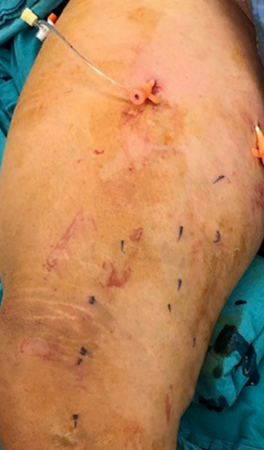
The saphenofemoral junction has a unique anatomy; however, may frequently include variations. Not only the great saphenous vein drains into the deep venous system around the saphenofemoral junction, but also other venous structures such as superficial circumflex iliac vein, superficial inferior epigastric vein, deep external pudendal vein, superficial external pudendal vein, medial tributary pudendal vein, medial tributary saphenous vein, anterior tributary saphenous vein are defined to drain either into the great saphenous vein or to the deep venous system in the region.8,9 All of these tributary venous collaterals are attempted to be determined pre- and peri-operatively in all of our patients in both groups. Recurrence of varicose veins as well as symptoms of the patients following the treatment of superficial venous reflux disease and varicose vein treatment is not an uncommon issue and an unresolved disturbing problem. In many of the cases, neovascularity or technical failures contribute to great saphenous vein insufficiency and subsequent recurrent varicose vein formations.10 The neovascularization or new reflux disease confined to the tributary venous pathways of the saphenofemoral junction is not a predictible issue in the follow up of patients with treated great saphenous vein reflux disease. In conventional stripping of great saphenous vein, the treatment also includes the ligation of tributary veins. In case of percutaneous superficial venous reflux disease treatment, the thermal or non-thermal ablation of great saphenous vein is achieved up to 2 cm distal to the saphenofemoral junction. The tributary veins draining this 2cm segment of great saphenous veins remain intact with such less invasive methods. We hypothesized prophylactic interference to the tributary veins might further reduce symptoms and new varicose vein formations in the long run with the same rationelle that is applied during great saphenous vein stripping; that is concommittant ligation of tributary veins. The results of our study supported our hypothesis as there was a decrease in recurrences of varices and symptoms in our prophylactic ablation group, the Group B. The anatomy of the saphenofemoral junction is very well known; however, may include tremendous variations. Ablation of the tributary superficial venous pathways during the treatment of great saphenous vein reflux disease is controversial11; however, decreased the risk of recurrence of superficial venous reflux disease in our modest cohort. Although we failed to show a statistically significant difference in tributary venous dilatation and reflux between Group A and Group B which may be attributed to the small number of the patients in the study, still the difference is remarkable. These tributary veins are not truncal veins like great and small saphenous vein. They are thin walled and small in diameters. Regarding to paper of Caggiati on cadavers and computerized tomography angiography of alive individuals, the tributary veins showed a subdermal path and were surrounded by an amorphous fatty tissue. Only the “Giacomini’s vein” and the cranial segment of the “anterior accessory saphenous vein” run deeply in the hypodermis, unsheathed by the muscular fascia and the membranous layer of the hypodermis. The wall of the tributary veins is not strong when compared with the saphenous veins due to the absence of intimal hyperplasia, to lesser muscularization and to scarce connective tissue proliferation. The absence of any fascial unsheathing and the parietal weakness are suggestive of a lower resistance of the tributary veins wall to increased endovascular pressure.12 On the other hand, catheterization of the veins draining into the deep venous system other than the great saphenous vein is not easy due to absence of fascial unsheathing and parietal weakness and causes collapse of vein while puncture and complex regarding to saphenous puncture. The patients in Group B experienced more ecchymosis around the thigh most probably related with the tributary venous puncture attempts. The majority of patients with recurrent varicose vein symptoms following the treatment of superficial venos reflux disease also have presence of perforating veins documented as well.13 Recurrences should be distingushed from residual varices. In general, there are two main reasons of recurrences due to anatomical and hemodynamical reasons. From the anatomical point of view, they can result from a technical error as excessively low ligation/ablation of the long saphenous vein away from the saphenofemoral junction, with persistence of a stump of arch persistence of a subfascial anterior branch (the most common cause), presence of an tributary saphenous vein or presence of a tributary draining directly into the femoral vein.